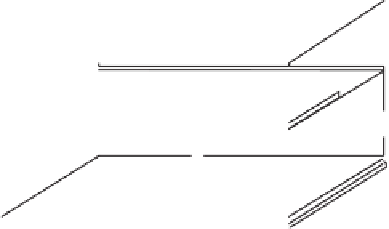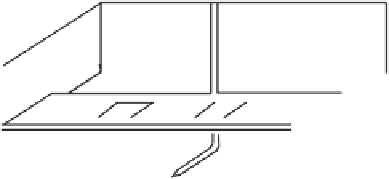Biomedical Engineering Reference
In-Depth Information
co
mputer
signal
processor
three degrees-of-freedom
manipulator
FNS
stimulator
glass tank
simulated skin layer
probe
saline solution
reference plate electrode
Figure 6.35
An electrolyte tank can be used to investigate how FNS currents applied through
skin electrodes distribute within the body to cause tissue stimulation. The setup consists of a
40 cm
30 cm
30 cm glass tank (a small aquarium) filled with isoconductive saline. A carbon-
loaded elastomer layer simulates the patient's skin. A differential probe made with two gold wires
exposed 1 mm to the saline solution and placed parallel 1 mm apart simulate the stimulation spatial
constant of myelinated axons. (From Sagi-Dolev et al. [1995]. Reprinted with permission from the
International Federation for Medical & Biological Engineering.)
A common trend in recent studies for the validation of inverse electrocardiography has
been to replace the synthetic signal source with a perfused dog heart, thus achieving a
much higher degree of realism by eliminating the limitations of representing the heart as
a single dipole rather than as a distributed source of bioelectric current. Obviously, the
main advantages of this type of preparation over instrumented whole-animal experiments
are the relative ease of carrying out the experiments and the increased level of control they
provide. The isolated heart is directly accessible when suspended in an electrolytic tank,
which permits manipulations of its position, pacing site, coronary
fl
ow, and temperature.
The simpli
ed geometry of the tank also makes constructing customized geometric mod-
els simpler and faster than when a complete medical imaging scan is required for a whole
animal.
Isolated heart systems are available from Hugo Sachs Electronik (now part of Harvard
Apparatus). The isolated heart apparatus uses a synthetic bloodlike solution to provide
oxygen and metabolic substrates for the heart to survive. Since the coronary system of the
heart relies on the pressure created by the heart itself for
fi
flow, the heart must be assisted
externally after explant from the donor animal. This is accomplished by pumping
fl
fl
fluid
directly into the coronary system and removing
fluid from the heart's four chambers to
ease the burden using a technique called the
Langendor
fl
ff
mode of perfusion
. Once the
heart is capable of maintaining pressures and
fl
flows independently, it is weaned out of
Langendor
flow pattern is reestablished. At that point the heart is
said to be in the
four-chamber working mode
, in which it generates pressures in all four
chambers and is responsible for the work required to maintain
ff
mode and the native
fl
fl
ow through the coronary
system, hence the name.































Search WWH ::

Custom Search